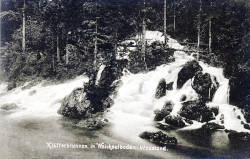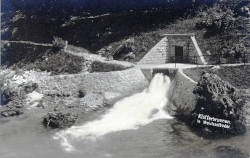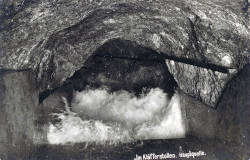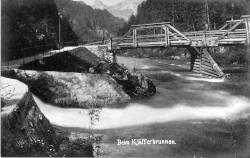Kläfferquelle
Kläfferbrünnequelle
Useful Information
| Location: |
13 km from Wildalpen.
(47.6479532, 15.1432635) |
| Open: |
Museum HochQuellenWasser:
MAY to OCT Mon-Fri 10-12, 13-15, Sun, Hol 10-12. Visits only for groups after appointment. [2025] |
| Fee: |
Museum HochQuellenWasser:
Adults EUR 7, Children (6-15) EUR 3, Children (0-5) free. Guided tour: Per Group EUR 20. [2025] |
| Classification: |
 Karst spring Karst spring
|
| Light: | n/a |
| Dimension: |
Average Yield: 4,790 l/s. Maximum Yield: 10,000 l/s. Minimum Yield: 1.000 l/s. |
| Guided tours: |
Museum: D=90 min. Kläfferquelle: D=30 min. |
| Photography: | allowed |
| Accessibility: |
Museum: yes. Kläfferquelle: no |
| Bibliography: |
Ing. Dr. Franz Musil (1927):
Die Wasserversorgung
In: Das neue Wien, Städtewerk. Band III. Herausgegeben unter offizieller Mitwirkung der Gemeinde Wien, Elbemühl, Wien 1927, S. 190–215.
online

Alfred Drennig (1988): Die II. Wiener Hochquellenwasserleitung Festschrift herausgegeben vom Magistrat der Stadt Wien, Abteilung 31 – Wasserwerke. Compress-Verlag, Wien 1988, ISBN 3-900607-11-7. online 
|
| Address: |
Kläfferquelle, Museum „HochQuellenWasser“, Säusenbach 14, 8924 Wildalpen, Tel: +43-3636-451-31870, Tel: +43-3636-451-31871, Cell: +43-676-811-831-870.
E-mail: |
| As far as we know this information was accurate when it was published (see years in brackets), but may have changed since then. Please check rates and details directly with the companies in question if you need more recent info. |
|
History
| 21-APR-1870 | Official start of construction of the Hochquellenleitung, ground-breaking ceremony by Kaiser Franz Joseph I. auf dem Gelände des Wasserbehälters Rosenhügel. |
| 24-OCT-1873 | Opening ceremony of the I. High Spring Pipeline with the commissioning of the Hochstrahlbrunnens on Schwarzenbergplatz by Kaiser Franz Joseph I. |
| 1874 | Completion of all parts of the first high-spring pipeline | .
| 02-DEC-1910 | II. Kaiser-Franz-Josef-Hochquellenleitung opened to reinforce the I. Hochquellenleitung. |
Description




The Kläfferquelle is one of the largest sources of drinking water in Europe. It was integrated into II. Wiener Hochquellenleitung (2nd Vienna High Spings Aqueduct) in 1910. This drinking water canal transports drinking water from the Hochschwab area in Styria to Vienna. A water protection area was established around the Brunngraben, Höllbach, Siebensee, Schreyerklamm and the Kläfferquelle. 217 million liters of water are transported to Vienna every day.
The history of Vienna’s water supply is a long one. Like many other medieval cities, it used the river, its tributaries, various wells and cisterns. Unfortunately, the rivers were also used as sewage conduits, and the water was no longer drinkable early on, later it was no longer even suitable for industrial use. The wells also ceased to be used in the 19th century due to the lack of a functioning sewerage system in the city. The contaminated aquifer led to epidemics. Water pipes were built from the south and west, some of which were privately owned by aristocrats. The Albertinische Wasserleitung or later the Kaiser-Ferdinands-Wasserleitung, which supplied the districts of Mariahilf, Neubau and Josefstadt, were built. Initially, the water pipes worked, but the massive exploitation of the aquifers led to their depletion and the quantity and quality of the water quickly declined. All of these smaller aquifers and bank filtrates were completely inadequate for the rapidly growing city.
This ultimately led to the construction of another water pipeline in the middle of the 19th century, originally called the Hochquellenleitung (High Spring Pipeline), then the Kaiser-Franz-Josef-Hochquellenleitung when it was opened. It transported the water from several large springs in the area of the Rax, Schneeberg and Hochschwab mountain massifs, and although the volume of water was significantly larger, as is typical for karst springs, there was much less water in the winter, and it was not enough at that time of year. The planners had not taken this characteristic of karst springs into account, karst hydrology was a very young science at that time. The II. Kaiser-Franz-Josef high spring pipeline was quickly built, to connect even more huge karst springs to Vienna. The name was adopted for the second high spring pipeline and both were simply numbered consecutively. When the name was changed to Wiener Hochquellenleitung after the First World War and the end of the monarchy, this also applied to both pipelines. Even the construction principle is the same.
The water flows by its own weight in the same way as it did in a Roman aqueduct, in a canal which is 192 cm wide and 208 cm high. The aqueduct has a total length of 183 km with a normal gradient of 0,22 ‰. The gradient causes a flow speed of 4 to 5 km/h, which means that the water moves about as fast as a hiker. The water needs 36 hours from Kläfferquelle to Vienna. Obviously, there is a gap: the distance of 180 km with 360 m height difference would result in an average gradient of 2.1 ‰. The difference is used for the production of electric energy. There are numerous so-called Wasserleitungskraftwerke (drinking water power plants) which produce electricity, which was used for the pumping of water in vienna. Once they had a separate network of electric wires, but today the electricity is added to the grid and the pumps use the electricity from te grid.
The disadvantage of such a system is that geographical height differences have to be compensated for somehow. If you follow a valley, this initially only affects the height on the slope, but each side valley means either building an aqueduct or extending the aqueduct into the side valley as far as necessary and back the other side. Due to the high construction and maintenance costs of the aqueducts, most of the side valleys were handled this way. Nevertheless, 100 aqueducts were built for the Second High Spring Pipeline alone. All of these aqueducts are listed buildings. Some tunnels were also necessary.
The Kläfferquelle is a karst spring, the yield depends on the recharge in the catchment area, the reaction on snow melt or heavy rains is called response time and counted in hours or a few days. Also, the spring produces dirty water with a high sediment content during maximum yield. During this time the spring is not used for drinking water. All the water is leaving the spring building through the overflow, and the often dry riverbed below is full of impressive rapids. At those high water events, a lot of small intermittent springs around the building also start to produce water and waterfalls with up to 70 m height form.
The historic spring buildings and the 90 m long tunnel into the mountain, which collects the water from the cave behind, are open for tourists on special tours. Groups of minimum 10 persons can make a reservation at the Museum HochQuellenWasser. This is the new name of the Wasserleitungsmuseum Wildalpen which is also a Heritage and Parish museum housed inside a historic hammer mill. The guided tour includes the museum and the spring. The museum is located in an old hammer masters’ house, the Tulleck’schen Gewerkenhaus. It also houses the local history and parish museum.
Finally, however, we would like to point out that the Kläfferquelle karst spring is freely accessible and does not require a guided tour. The guided tour only concerns the water supply tunnel and the museum. And in contrast to this guided tour, the spring itself is best visited during high water, when all the secondary springs are active and even the main spring due to the discharge of spring water. A visit is therefore recommended when the snow is melting or after heavy rainfall, but is unfortunately difficult for the average tourist.
- See also
 Search DuckDuckGo for "Kläfferquelle"
Search DuckDuckGo for "Kläfferquelle" Google Earth Placemark
Google Earth Placemark II. Wiener Hochquellenleitung
II. Wiener Hochquellenleitung  - Wikipedia (visited: 15-JUN-2020)
- Wikipedia (visited: 15-JUN-2020) Kläfferquelle
Kläfferquelle  (visited: 29-JUN-2025)
(visited: 29-JUN-2025) Kläfferquelle - Wasserversorgung in Wien (visited: 15-JUN-2020)
Kläfferquelle - Wasserversorgung in Wien (visited: 15-JUN-2020) Museum HochQuellenWasser Wildalpen, official website
Museum HochQuellenWasser Wildalpen, official website  (visited: 15-JUN-2020)
(visited: 15-JUN-2020) Zweite Hochquellenleitung
Zweite Hochquellenleitung  (visited: 15-JUN-2020)
(visited: 15-JUN-2020) MUSEUM HOCHQUELLENWASSER UND KLÄFFERQUELLE
MUSEUM HOCHQUELLENWASSER UND KLÄFFERQUELLE  (visited: 29-JUN-2025)
(visited: 29-JUN-2025) Kläfferquelle – Naturschauspiel im Frühjahr
Kläfferquelle – Naturschauspiel im Frühjahr  (visited: 15-JUN-2020)
(visited: 15-JUN-2020) Naturschauspiel Kläfferquelle
Naturschauspiel Kläfferquelle  (visited: 15-JUN-2020)
(visited: 15-JUN-2020)
 Index
Index Topics
Topics Hierarchical
Hierarchical Countries
Countries Maps
Maps